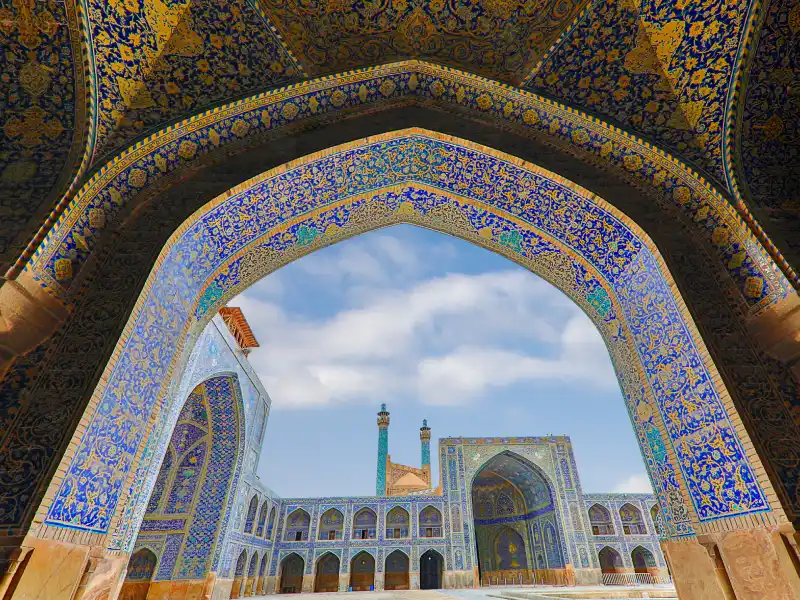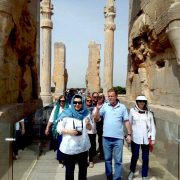Naqsh-e Jahan Square, Isfahan (History, Photos, Location)
Naqsh-e Jahan Square, also known as Imam Square, is one of the most breathtaking architectural and cultural landmarks in Iran. Situated in the heart of Isfahan, this historic square is renowned not only for its aesthetic beauty but also for its profound historical significance. With its grand structures, unique layout, and vibrant history, Naqsh-e Jahan Square captures the heart and soul of Persian architecture, heritage, and craftsmanship.
This square is often considered a symbol of the rich cultural heritage of Iran. Its construction, spanning the early 17th century, was a marvel of urban planning and a testament to the architectural vision of its time. Each corner of the square tells a story of Iran’s golden age of art and culture, making it a beloved destination for travelers and historians alike.
About Naqsh-e Jahan Square
Naqsh-e Jahan Square, which translates to “Image of the World Square,” is part of Isfahan’s historic city center and reflects Iran’s rich architectural legacy. Covering approximately 89,600 square meters, it is one of the largest public squares in the world. The square serves as a focal point for the city, bringing together grandiose structures, lively markets, and significant religious sites, all of which add to its charm and cultural richness.
The design of Naqsh-e Jahan Square aligns with traditional Persian garden layouts, often symbolizing paradise. Its impressive design and detailed architectural features make it an iconic representation of Persian aesthetics, blending both functionality and beauty.
Who Built Naqsh-e Jahan Square?
The construction of Naqsh-e Jahan Square began during the reign of Shah Abbas I of the Safavid dynasty in the early 1600s. Shah Abbas envisioned Isfahan as a grand cultural and economic hub, and this square was the centerpiece of his vision. Built over several years, Naqsh-e Jahan Square showcased the advancements in Persian architecture and city planning. The square was designed by the renowned architect Sheikh Baha’i, who was instrumental in blending the art, spirituality, and utility of the square’s design.
Under Shah Abbas’s leadership, Naqsh-e Jahan Square became a place for royal ceremonies, celebrations, and sports, such as polo. To this day, it remains an emblem of Iran’s historical and cultural achievements.
Things to Do in Naqsh-e Jahan
Naqsh-e Jahan Square is a true masterpiece itself, but it also contains some of the most historical and cultural centers of Isfahan within itself. Here are the top things to do in Naqsh-e Jahan Square:
Shah Mosque
The Shah Mosque of Isfahan, also known as the Imam Mosque, is a radiant symbol of Persian ingenuity and spiritual devotion, crowning the southern side of Naqsh-e Jahan Square with timeless elegance. Its monumental portal invites visitors into a world where light, symmetry, and sacred geometry converge in harmony.
The mosque’s signature turquoise dome, one of the tallest in Iran, appears to float above a sea of intricate floral and calligraphic tilework, each pattern telling a silent story of divine inspiration. Beyond its aesthetic marvels, the mosque’s layout reflects deep cosmological meaning, aligning architecture with celestial principles. Every echo under its dome and glint of glazed tile speaks to a civilization that saw beauty as a pathway to the divine.
Opening Hours: Daily from 9:00 AM to 11:00 AM and 1:00 PM to 4:30 PM
Sheikh Lotfollah Mosque
Tucked gracefully on the eastern side of Naqsh-e Jahan Square, the Sheikh Lotfollah Mosque is a jewel box of Persian architecture, renowned for its quiet elegance and exquisite tilework. Unlike typical mosques, it lacks minarets and a courtyard, hinting at its exclusive use for the royal court.
Built during the reign of Shah Abbas I, this 17th-century marvel dazzles with a glowing cream-colored dome that shifts hue with the changing light of day, and a labyrinthine entrance hallway that masterfully orients worshippers toward Mecca. Inside, a kaleidoscope of delicate arabesques and peacock-feather patterns creates a sacred intimacy, making it less a public monument and more a divine secret whispered in stone and color.
Opening Hours: Daily from 9:00 AM to 12:30 PM and 2:00 PM to 6:00 PM
Ali Qapu Palace
Ali Qapu Palace stands majestically on the western side of Naqsh-e Jahan Square. Rising above Naqsh-e Jahan Square, the Ali Qapu Palace is a stunning fusion of regal authority and artistic ingenuity. Commissioned by Shah Abbas I, this imperial residence served both as a gateway to the square and a royal vantage point for observing festivities below.
The highlight lies in its top-floor music hall, where carved stucco niches in the walls not only amplify sound but resemble musical instruments themselves, turning architecture into acoustics. The palace’s sweeping terrace offers a commanding view of the square, while its mural-adorned rooms reflect the lavish aesthetic and courtly refinement of the Safavid dynasty. Ali Qapu doesn’t just display royal power—it orchestrates it with rhythm and grace.
Opening Hours: Daily from 9:00 AM to 6:00 PM
Isfahan Grand Bazaar
The Grand Bazaar of Isfahan, one of the oldest and largest bazaars in the Middle East. The Grand Bazaar of Isfahan, also known as Qeisariyeh Bazaar, is a living labyrinth of commerce, craftsmanship, and culture that has pulsed with life for centuries. Stretching from Naqsh-e Jahan Square deep into the heart of the old city, this bazaar is more than a marketplace—it’s a sensory journey through time.
Vaulted passageways echo with the sounds of bargaining and artisans at work, while the scent of spices and the shimmer of Persian carpets evoke stories of trade routes and dynastic splendor. Built during the Safavid period, it connects monumental architecture with everyday life, blending the grandeur of empire with the hum of daily hustle. In every alley and archway, the bazaar whispers the soul of Isfahan.
Opening Hours: Generally from 9:00 AM to 6:00 PM; some shops may close on Fridays
Naqsh-e Jahan Square Facts
Naqsh-e Jahan Square is notable for being the second-largest square in the world, after Tiananmen Square in Beijing. It also stands out as a UNESCO World Heritage Site, recognized for its architectural and cultural significance. Each side of the square hosts a unique architectural masterpiece, including mosques, palaces, and a bazaar, showcasing the distinctive Islamic and Persian styles.
The square’s dimensions (560 meters long and 160 meters wide) are perfectly symmetrical, with pathways and pools strategically positioned to enhance the beauty of its surroundings. These thoughtful details add to its allure and testify to the meticulous planning of Persian architects.
Naqsh-e Jahan Square Location
Naqsh-e Jahan Square’s layout combines beauty, symmetry, and functional design. Its rectangular shape and well-balanced architectural features provide visitors with a harmonious experience as they stroll through the site. Four primary attractions are situated along each side of the square, each serving different roles, religious, political, and commercial.
The northern side houses the bustling Qeysarieh or Isfahan Grand Bazaar, while the east side features the Sheikh Lotfollah Mosque, famous for its delicate tilework. On the west side lies Ali Qapu Palace, which once served as a royal residence, and on the south is the grand Shah Mosque, a masterpiece of Safavid architecture.
You can reach the Naqsh-e Jahan Square in the very center of Isfahan city.
Naqsh-e Jahan Square Plan
Naqsh-e Jahan Square is located in the center of Isfahan, Iran. The city itself is accessible by plane, train, and bus, making it a popular destination for both domestic and international travelers. Situated within walking distance from many historical sites in Isfahan, the square is easily reachable for visitors who wish to immerse themselves in Iran’s rich cultural heritage.
The central location of the square also makes it a lively meeting place for locals and tourists alike. It’s surrounded by hotels, restaurants, and shops, which offer visitors a chance to experience Persian hospitality and taste local delicacies.
Naqsh-e Jahan Square Reviews
Visitors from around the world often describe Naqsh-e Jahan Square as an awe-inspiring site that transports them back to ancient Persia. The intricate architecture, combined with the serene ambiance, creates a captivating experience for everyone who steps into the square. Many tourists highlight the beauty of the tilework in the mosques, the historical significance of Ali Qapu Palace, and the vibrant atmosphere of the bazaar.
Some travelers recommend visiting the square during the late afternoon when the sunlight casts a golden glow over the buildings, adding to its mystical allure. Overall, the square’s ambiance and historical richness leave a lasting impression on all who visit.
Last Words
Naqsh-e Jahan Square is much more than a historical landmark; it is a cultural icon that embodies the artistic achievements of Persian civilization. Its architectural marvels, coupled with the deep history that surrounds it, make Naqsh-e Jahan Square a must-visit destination for anyone interested in Iranian history and culture. Today, it stands as a timeless proof of Iran’s legacy, inspiring visitors with its beauty and historical significance.
Naghshe Jahan Square, a showcase of the most beautiful artistic works from the Safavid era, became a UNESCO World Heritage site in 1979 and is the highlight of every culture tour to Iran.
Are you planning to travel to Iran and looking for an Iran travel agency? Check out our Iran tours.


















Leave a Reply
Want to join the discussion?Feel free to contribute!